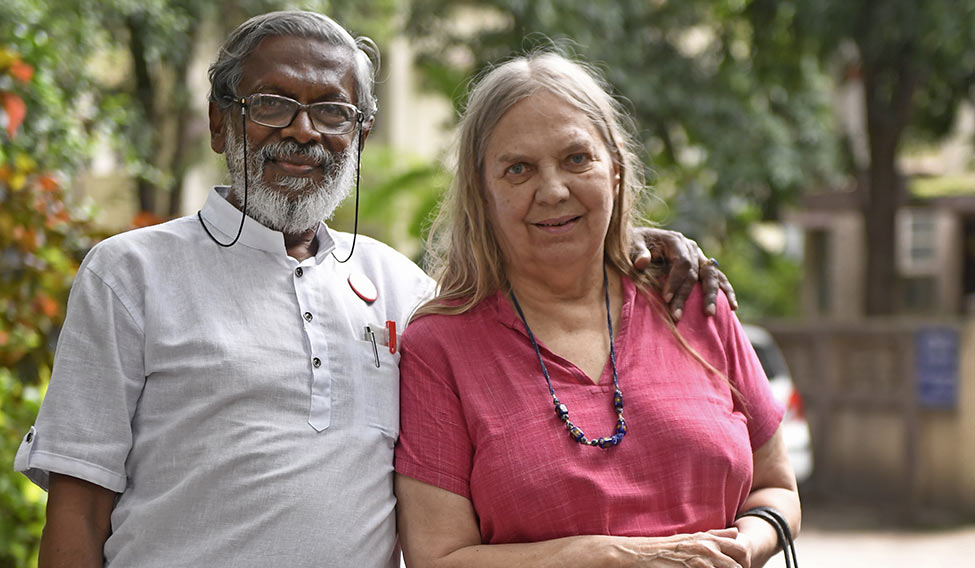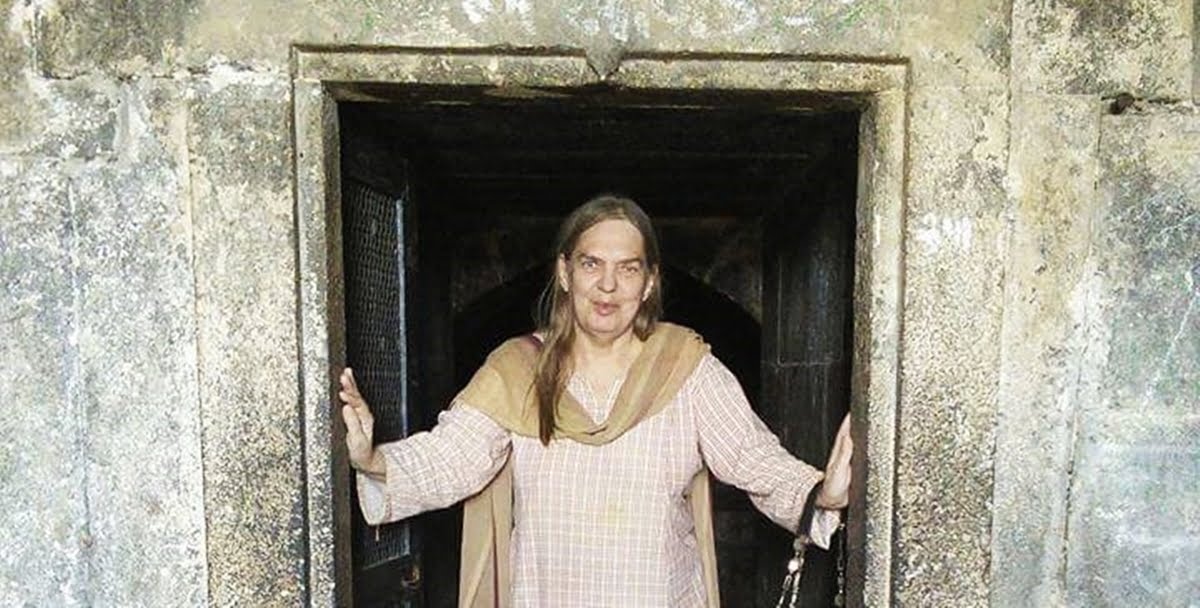Dr. Gail Omvedt was born in Minneapolis, the USA, in 1941. She was an American-born Indian scholar who completed her PhD from the University of California, Berkeley. She was my first introduction and inception to the Ambedkarite Movement in India. With no awareness about my social position and ancestral history, Gail Omvedt became an accessory to the development of my political praxis. Her work on ‘Ambedkar and After: The Dalit Movement in India’ which was a part of my Sociology syllabus encouraged me to recognise my identity and the history of my own community.
Gail Omvedt provided me the impetus to engage and participate in the Ambedkarite Movement in India and was a mentor who enlightened me on historical oppression of my own caste community. Though born and brought up within the Ambedkarite environment, my caste conditioning never enabled me to acknowledge and study the history of caste in India. It was Gail, who provided the language to my anti-caste politics as a university student. Reading the history of my identity and drawing inspiration from the works and politics of anti-caste scholars like Gail was overwhelming and emancipatory to an oppressed caste person who had been purposefully denied the knowledge of their identity.
Mentor who enlightened me on historical oppression of my own caste community. Though born and brought up within the Ambedkarite environment, my caste conditioning never enabled me to acknowledge and study the history of caste in India.
Gail Omvedt’s systematic and scholarly account of the Ambedkarite Movement in India, challenged the Gandhian orientation of traditional vision and provided a sharp commentary on Ambedkar’s work that aimed to develop a totalistic and all-encompassing theoretical framework of subaltern movement as an alternative to Marxism. Gail elaborately wrote on Ambedkar’s liberatory message of Buddhism as a emancipatory path for the ex-untouchables of India. In one of her works, Gail mentions that the Dalit poetry frequently uses the sun as the imagery movement led by Dr. B.R Ambedkar, seeing him as the sun and the bringer of a total new world. Perhaps, the same imagery is reflected in the Marathi Bhim Geet titled ‘Soniyachi ugavli sakal’ which recognises the dawn of Ambedkar’s birth as prelude to a free nation.
Also read: Poster Series: Remembering Gail Omvedt
Gail Omvedt also wrote that Ambedkar envisaged the process of change as an internal spiritual change, social struggle, political dialogue and political organising. Of this, the powerful statement of Ambedkar that proclaims ‘the slave’s rejection of slavery’ forms the cornerstone of a developing anti-caste consciousness among the oppressed caste persons. Thus, Gail’s writing also became my first encounter with Ambedkar’s anti-caste literature as well.
Gail Omvedt provided me with the currency of language and articulation to assert my identity politics in a Savarna dominated University space that scrutinises any account of lived experiences as short of academic rigour. The groundbreaking contentions of her academic composition made me realise how significant it is to postulate such counter narratives in the study of social sciences in India. The inclusion of these counter political and cultural expositions enables one to familiarize themselves with their identity, the knowledge of which has been systematically denied to them as an attempt to preserve and hegemonize education by caste forces in India.
Rejecting Orientalist, nationalist and Hindutva impulses to ‘reinvent’ India, Gail Omvedt, in her synopsis on ‘Begumpura’ “threads together the worldviews of subaltern visionaries spanning five centuries—Chokhamela, Janabai, Kabir, Ravidas, Tukaram, the Kartabhajas, Phule, Iyothee Thass, Pandita Ramabai, Periyar, and Ambedkar. These are contrasted with Gandhi’s village utopia of Ram Rajya, Nehru’s Hindutva-laced brahmanic socialism and Savarkar’s territorialist Hindu Rashtra. Reason and ecstasy—dhyan and bhakti—pave the road that leads to the promised land.”
Gail Omvedt, who passed away at the age of 81 on August 25th in Kasegaon, Sangli of Maharashtra was a rare public intellectual who engaged in the theory and praxis of social justice politics. Her writings were transformative and impactful because she infused them by actively engaging in the political field of social justice movements. Omvedt was an American-Indian sociologist who initiated her engagement with the cultural politics of India with the advent of the ‘hippy era’ of the 1960-70s in America. While this approach of delving and learning from other cultures gained a momentum in America, most Oriental scholars focused on the Brahmanic tradition of the Indic past. On the other hand, Omvedt who was a contemporary of the same era chose to study the real, ideal and people’s India as opposed to the upper caste India.
She came to India in 1963 to work on her dissertation titled ‘Cultural Revolt in a Colonial Society: The Non-Brahman Movement in Western India,1873-1930’ and later published as a book in 1976. Gail Omvedt received wide acclaim from the Bahujan community and scholars for her empathetic and strictly non-appropriating approach in studying subaltern society in India. In 1978, she finally chose to settle in India and married the Phuleit, Marxist activist Dr. Bharat Patankar. She, along with Patankar, co-founded a socio-political platform called the Shramik Mukti Dal (or the Toilers’ Liberation League) which has been actively organising farmers and workers on issues of drought, dam and project eviction, and caste oppression in over 10 districts in Maharashtra. The organisation was the outcome of Omvedt and Patankar’s deep engagement with Marx-Phule-Ambedkarism.

Throughout her activism, Gail Omvedt was critically aware of the difference between allyship and appropriation. She never hogged space and took the limelight in her Ambedkarite activism unlike other upper caste scholars like Arundhati Roy in India. Gail always stood as a comrade, as an ally and believed in encouraging indigenous representation and leadership.
Throughout her activism, Gail Omvedt was critically aware of the difference between allyship and appropriation. She never hogged space and took the limelight in her Ambedkarite activism unlike other upper caste scholars like Arundhati Roy in India. Gail always stood as a comrade, as an ally and believed in encouraging indigenous representation and leadership.
Analytically, Gail Omvedt’s sociological works also reflect C. Wright Mill’s tradition of ‘sociological imagination’. Such an imagination focuses on developing a quality of mind that will help them use information and to develop reason in order to achieve lucid summations of what is going on in the society and of what may be happening within themselves. Sociological imagination enables its possessor to understand the larger historical scene in terms of its meaning for the individual life and how individuals in the welter of their daily experience often become falsely conscious of their social positions. In the context of India, the ‘sociological imagination’ enabled the Bahujans and the oppressed caste community to grasp the historical biography of India and the relations between the two in the society. Thus, in merging scholarship and activism, Omvedt made academic research accessible to all.
Throughout her career, Gail Omvedt moved from the library to the field, from academia to activism, each feeding the other. Her profound works and prolific writing in over 25 books and many dozens of academic papers that cut through the intersections of various identities and concerns makes her a distinguished scholar. Her overarching contribution in the field of Indian Sociology will always be renowned for its literary and practical value. Her feat and legacy will forever remain and inspire aspiring sociologists and other social researchers in India.
Also read: How Upper-Caste Women Continue To Dominate The Women’s Movement in India
References
- In Merging Scholarship and Activism, Gail Omvedt Made Academic Research Accessible for All
- Gail Omvedt took caste to global audience that was fed only a Brahminical point of view
- Gail Omvedt’s work explored spaces where theory met praxis, her activism informed her writing
Featured image source: Newsclick
About the author(s)
Mansi Bhalerao is an Ambedkarite feminist, an undergraduate at Miranda House. She is an aspiring student of Sociology, trying to navigate and assert her praxis.




